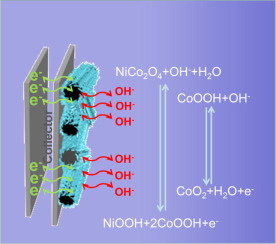Journal of Colloid and Interface Science ( IF 9.9 ) Pub Date : 2018-09-12 , DOI: 10.1016/j.jcis.2018.09.037 Ying Yang , Dehong Zeng , Senjie Yang , Lin Gu , Baijun Liu , Shijie Hao

|
Core-shell structured carbon [email protected] oxide is one of the most promising hybrid electrodes as supercapacitors, in which the pseudocapacitive metal oxides can be fully exerted and stabilized on the carbonaceous scaffolds. However, facile fabrication of mesoporous carbon nanofibers and integration of them with metal oxides are challenging. Herein, we report a new type of mesoporous carbon nanofibers (MCNs), derived from zinc-trimesic acid fibers, acting as the scaffolds to anchor nickel cobaltite (NiCo2O4) nanosheets after surface O-functionalization. The resultant core-shell [email protected]2O4 nanostructure is demonstrated by scanning electron microscope (SEM), elemental mapping, bright-field/high-resolution transmission electron microscope (TEM), selected area electron diffraction (SAED) studies. The anchored NiCo2O4 nanosheets are dense (97.4%), and have a strong interaction with OMCN, as revealed by X-ray diffraction (XRD), X-ray photoelectron spectroscopy (XPS), thermogravimetric analysis (TGA) and H2-temperature programmed reduction (H2-TPR) techniques. As expected, the [email protected]2O4 is highly efficient, showing a high specific capacitance of 1631 F g–1 at the current density of 1 A g–1, excellent rate capability and superior cycling stability up to 5000 cycles within a high capacitance retention ratio of 94.5%. This research opens the avenue to fabricate high-efficiency carbon-metal oxide electrodes using metal-organic framework fiber-derived mesoporous carbon nanofibers and integration of them with NiCo2O4 nanosheets by increasing the interfacial interaction.
中文翻译:

镍钴纳米片涂覆在金属有机骨架衍生的介孔碳纳米纤维上,用于高性能伪电容器
核-壳结构碳(受电子邮件保护的)氧化物是作为超级电容器最有前途的混合电极之一,在其中伪电容金属氧化物可以充分发挥并稳定在碳质支架上。然而,介孔碳纳米纤维的容易制造以及它们与金属氧化物的整合是具有挑战性的。在本文中,我们报告了一种新型的介孔碳纳米纤维(MCNs),该碳纤维由锌-三羟甲基磺酸纤维衍生而成,在表面O-官能化后,可作为锚固钴镍矿(NiCo 2 O 4)纳米片的支架。生成的内核-shell [受电子邮件保护] 2 O 4通过扫描电子显微镜(SEM),元素图谱,明场/高分辨率透射电子显微镜(TEM),选择区域电子衍射(SAED)研究证明了纳米结构。X射线衍射(XRD),X射线光电子能谱(XPS),热重分析(TGA)和H 2揭示了锚固的NiCo 2 O 4纳米片致密(97.4%),并且与OMCN有很强的相互作用。程序升温还原(H 2 -TPR )技术。不出所料,[电子邮件保护的] 2 O 4效率很高,在1 A g –1的电流密度下显示出1631 F g –1的高比电容在94.5%的高电容保持率下,具有出色的速率能力和高达5000次循环的出色循环稳定性。这项研究为使用源自金属有机骨架纤维的介孔碳纳米纤维并通过增加界面相互作用将它们与NiCo 2 O 4纳米片集成而开辟了制造高效碳-金属氧化物电极的途径。



























 京公网安备 11010802027423号
京公网安备 11010802027423号